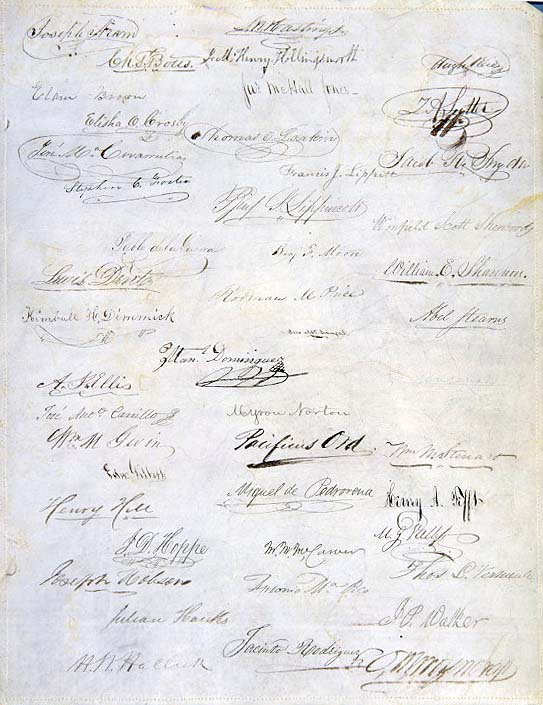Colton Hall in Monterey, circa 1890, where California’s first constitution was crafted. Cal State Chico
California’s first constitution reflected a state that was young, confident, and multilingual
All at once in the mid-19th century, the Mexican-American war ended and the Gold Rush began. California swelled with a sense of both optimism and foreboding.
Young men from all over the world were pouring into the western lands ceded by Mexico. Even soldiers deserted their posts to try their luck in the gold fields. But violence and lawlessness boiled over, threatening every class.
Californians hungered for stability. And so it was that on this week in 1849 a group of 48 delegates gathered in Monterey’s Colton Hall to draft the state’s first constitution.

From left, John Stutter, Mariano Guadalupe Vallejo, and Stephen Clark Foster were among the drafters of California’s first constitution.
California State Library, Cal State Chico, Los Angeles Public Library
The group, all men and most under the age of 40, reflected the frontier region’s immigrant character. They came from California, New York, Spain, Ireland, France, and other places. Among them were major figures of early California such as John Sutter, Mariano Guadalupe Vallejo, and Stephen Clark Foster.
The men plotted the state’s shape, agreeing that the Sierra range should mark the eastern border. After heated debate, they embraced a number of forward-thinking provisions. Slavery was prohibited, and women were allowed to own property.

The signature page of California’s 1849 constitution.
Six weeks later, the document was done, written painstakingly on 19 parchment pages in both English and Spanish.
To thank the citizens of Monterey for their hospitality, the delegates held a celebration that included a feast of roast pig, beef, and wine. Men in military uniform and ladies in pink and scarlet finery danced into the wee hours at Colton Hall, which was lit by chandeliers and decorated with pine boughs draped in the colors of the American flag.
Bayard Taylor, a traveling journalist, marveled at the diversity of the gathering: “The dark-eyed daughters of Monterey, Los Angeles, and Santa Barbara mingled in pleasing contrast with the fairer bloom of the trans-Nevadian belles,” he wrote. “The variety of feature and complexion was fully equalled by the variety of dress.”
The next morning, on Oct. 13, the delegates reconvened for a signing ceremony. As they affixed their names to the new constitution, an American flag was hoisted and 31 gunshots were fired — one for each state plus California. With the final boom, someone shouted. “That’s for California!”
Sutter, an elder among the group at age 46, was moved to tears. “Gentlemen,” he declared, “This is the happiest day of my life.”
This article is from the California Sun, a newsletter that delivers California’s most compelling news to your inbox each morning — for free. Sign up here.
Get your daily dose of the Golden State.